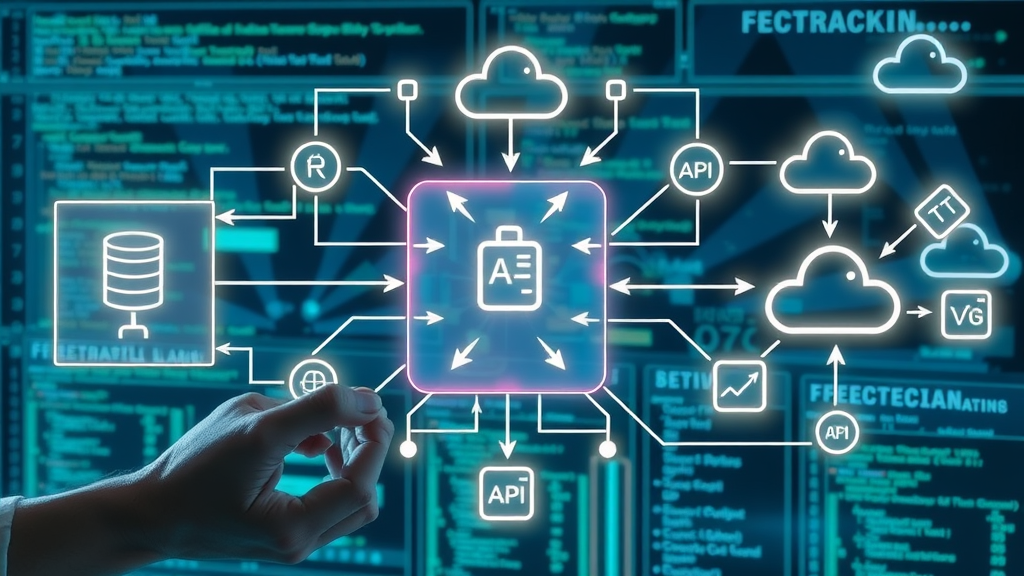Imagine this: You launch your website or app, only to see it go offline because of a single, hidden server error. With 70% of downtime in modern web applications directly tied to overlooked back-end development pitfalls, ignoring routine troubleshooting is no longer an option. If you want reliable, scalable digital solutions—as a web developer, backend developer, or business owner—mastering troubleshooting for server-side issues is your edge. This comprehensive guide will demystify the core of back-end development, give you real-world fixes for typical problems, and reveal the essential technical skills every backend developer needs to thrive in a fast-evolving tech landscape.
The Reality Behind Back-End Development Troubleshooting (A Data-Driven Perspective)
Did you know that 70% of downtime in modern web applications is directly tied to overlooked back-end development pitfalls?

- You will learn throughout this article:
- How back-end development powers today’s most reliable web services
- Common causes and real-world fixes for server-side issues
- Key technical skills and tools every backend developer must master
- Industry insights on the evolving role of the end developer
Back-end development is the invisible powerhouse keeping your favorite web applications running smoothly. When troubleshooting is neglected, digital services falter—sometimes spectacularly. In backend dev , identifying and addressing system bottlenecks isn’t just routine maintenance, it’s the critical frontline defense against mounting user complaints, revenue loss, and reputational damage. Today, we'll walk you through exactly how industry-leading backend developers approach problem-solving, equip you with lists of the most common server-side pain points, and demonstrate hands-on solutions that drive real business results.
What is Back-End Development? Understanding Its Core Role
Back-end development refers to the behind-the-scenes processes that enable digital applications—like a web app or mobile app—to function seamlessly. While the front end is what users interact with, the server side is the backbone, ensuring that information is stored, processed, and served as needed. The backend includes databases, application logic, servers, and APIs—core elements that dictate an application’s reliability, security, and scalability.
In every successful web application, the back end is the brain. It responds to user requests, pulls data from a database , processes logic, and returns appropriate content via APIs—all while maintaining vital security protocols. For businesses, this means a direct correlation between backend development excellence and enhanced user experience, better uptime, and higher customer satisfaction. Whether you’re a dedicated backend developer or a full stack developer, understanding back-end development fundamentals is foundational for troubleshooting issues and preventing future downtime.
The Relationship Between End Development and Backend Dev
“End development” refers to the complete process of creating digital products from user interface design through database management. Backend dev is a critical segment of this process, providing the infrastructure and logic necessary for the front end to function. An end developer is often expected to have a strong grasp of both frontend and backend disciplines, which ensures efficient communication between user-facing elements and data storage or business logic layers.
The relationship between the two is symbiotic: front-end development focuses on crafting engaging, intuitive experiences for users, while backend development ensures those experiences are powered by secure, high-performing systems. The more an end and back developer collaborate, the more robust and scalable the final application becomes.
Backend Development vs. Frontend Development: What Sets Them Apart?
Back-end development is all about building, maintaining, and optimizing the core systems users never see. Frontend development is all about creating the visual and interactive experiences users engage with. While backend deals with databases, servers, APIs, and business logic, the frontend focuses on design, layout, and user interaction. However, successful web applications demand a seamless handshake between both; slow or buggy backend processes are instantly noticed at the frontend.
To illustrate: when you update your profile picture on a social app, the frontend lets you upload and crop the image, but it’s the backend developer’s code that saves the image to the database, updates your account, and ensures everything loads correctly on your next login.
Key Components Every Backend Developer Should Know
Mastering back-end development means understanding the essential building blocks— databases , servers , and APIs . These elements are the very core of digital infrastructure for everything from a simple blog to robust multi-user web applications. Let’s break down why each is vital and see which tools professional backend developers rely on.
Databases store and organize the information your app relies on, while servers handle requests, orchestrate data flow, and enforce business logic. APIs act as bridges, connecting your back end to external services, the frontend, or even third-party applications. Knowing how to build, secure, and optimize these components is non-negotiable for anyone calling themselves a backend or end developer.
Databases, Servers, and APIs: The Cornerstones of Back-End Development

Understanding how databases, servers, and APIs interact is critical for troubleshooting and scaling web applications. Databases like MySQL, PostgreSQL, or MongoDB store structured or unstructured data. Servers, such as Apache and Nginx, interpret backend code, handle complex logic, and route requests. APIs (Application Programming Interfaces) expose controlled avenues for the frontend—or even external apps—to safely access and alter backend data.
The modern backend developer is as much an architect as a coder. With each API endpoint or database query, you’re dictating how quickly information flows, how securely data is stored, and how reliably services are delivered to the end user. If any of these areas falter, it’s up to the developer to quickly identify and resolve the root cause using precise troubleshooting methods.
| Component | Definition | Common Tools |
|---|---|---|
| Database | Data storage and retrieval | MySQL, PostgreSQL, MongoDB |
| Server | Manages client requests | Apache, Nginx |
| API | Communication bridge | REST, GraphQL |
Programming Languages Crucial for Back-End Development
All powerful back-end solutions are grounded in robust programming languages . Backend developers often work with high-demand languages such as Python, Java, Ruby on Rails, Node.js, or PHP. Each has strengths; for instance, Python’s readable syntax accelerates development, while Java is highly scalable for enterprise-grade applications. Understanding which language fits a specific web app or server-side scenario is a hallmark of a skilled backend dev.
It’s not just about one language—modern backend development requires fluency in multiple programming languages and frameworks. This allows you to adapt to various project needs, troubleshoot diverse issues efficiently, and integrate new technologies with minimal friction.
Version Control and Deployment: Streamlining Backend Dev Workflows
Version control is the unspoken hero of successful back-end projects. Tools like Git and GitHub allow teams to track changes, collaborate on code, and roll back errors—or restore lost functionality—within seconds. A solid grasp of version control is not just a technical skill; it’s essential for preventing data loss, securing intellectual property, and ensuring business continuity for any backend developer or end developer team.
Deployment is where troubleshooting transitions to real-world impact. Automated pipelines (CI/CD tools like Jenkins or GitHub Actions) ensure that code changes pass through tests and security scans before reaching production servers. Mastering automated deployment means reduced human error, faster updates, and greater stability—key factors in reliable web application performance.
Typical Back-End Development Challenges and Solutions
Even the best-planned systems face unexpected issues. Back-end development troubleshooting is about quickly identifying the source of a problem and deploying the right fix before downtime impacts users. Understanding the root causes of server-side errors prepares end and back developers to build more resilient solutions in both web development and mobile app contexts.
Typical challenges can include resource bottlenecks, API request failures, or subtle database connectivity issues. Each type of problem requires specific diagnostic skills and tailored technical solutions—often across multiple layers of the technology stack. By learning to spot these patterns early, backend devs dramatically reduce both downtime and long-term support costs.
Diagnosing Server Issues: End Developer’s First Line of Defense

Diagnosing server issues quickly is the hallmark of an expert back-end developer. Most symptoms—slow response times, data not saving, unresponsive APIs—can be traced to one of several common categories. Let’s look at the principal culprits backend and end developers encounter during daily troubleshooting:
- Resource bottlenecks
- Database connectivity failures
- API request timeouts
To troubleshoot effectively, backend devs analyze logs, monitor system performance, and simulate user requests. Isolating the precise trigger is crucial—sometimes a slow relational database query causes the performance hit, other times it’s a misconfigured API endpoint. Relying on technical skills like log analysis, real-time monitoring, and staged rollbacks, top backend developers resolve server issues before they escalate into widespread outages.
Backend Dev Solutions: Real-World Case Studies
Consider this scenario: A major e-commerce site begins experiencing frequent API timeouts. By reviewing system logs, backend developers discover a surge in malformed user requests after a new mobile app release. The fix involved refining input validation and scaling the API layer horizontally—which returned performance to normal and prevented further outages.
In another case, a web app’s data wouldn’t sync due to intermittent database connectivity failures. Backend devs traced the problem to a recent cloud infrastructure update that changed network firewalls. The resolution required updating server credentials and whitelisting specific endpoints, demonstrating why layered diagnostic skills are indispensable in back-end development.
Essential Technical Skills for Modern Backend Developers
The modern backend developer blends technical expertise with adaptive problem-solving. Beyond coding, you’ll need systems thinking, database design, and team collaboration to excel. From mastering frameworks and programming languages to effective communication—these skills form the foundation of successful end and back-end development projects.
Continuous learning, adaptability, and strong project management are vital for backend devs aiming to keep up in an environment where languages, frameworks, and best practices evolve with breakneck speed. The best backend developer isn’t just a code writer—they’re a systems architect, a problem preventer, and a results-driven collaborator.
Programming Languages and Frameworks That Drive End Development

Backend and end developers lean heavily on a few core programming languages. The most popular include Python (for its versatility), Java (for its scalability), JavaScript/Node.js (for real-time APIs), PHP (for content-driven web apps), and Ruby on Rails (for rapid prototyping). These languages sit at the heart of every application program and programming interface on the server side.
Frameworks—such as Django, Spring Boot, Express.js, and Laravel—amplify productivity and enforce best practices. By mastering multiple frameworks, end developers can select the right tool for a project, deploy secure and fast APIs, and accelerate time to market. The future belongs to backend developers who continually expand their technical skills with emerging languages and libraries.
Database Management Skills in Backend Development
Whether you’re leveraging a relational database like PostgreSQL or a NoSQL solution such as MongoDB, strong database management is a must. Backend devs are tasked with designing efficient schemas, writing optimized queries, implementing proper indexing, and ensuring data security. Good database management means faster web application response times, reduced costs, and happier users.
With cloud-native solutions on the rise, backend development now involves not just on-premises SQL database setup but also orchestration of distributed, scalable data stores. Understanding trade-offs—and troubleshooting connectivity or performance issues—is an essential part of the modern backend developer’s toolkit.
Soft Skills and Teamwork in End Development
Technical skills alone don’t guarantee success in back-end development. The best backend developers excel at communication, project management, and collaboration. They bridge the gap between front end and back end teams, ensuring both sides of the application function harmoniously, and that business requirements translate into code that performs flawlessly.
Empathy for the end user and a knack for cross-functional teamwork set excellent back-end and end developers apart. These soft skills are critical for debugging complex, multidisciplinary issues that require buy-in from operations, security, and product management teams as well.
"A star backend developer is a problem-solver who bridges technology and business outcomes—often before issues escalate."
People Also Ask: Answering Top Backend Development Questions

What is backend development?
Backend development is the process of creating the systems and logic that enable a web app, mobile app, or software to function behind the scenes. It focuses on servers, databases, and application programming interfaces (APIs)—everything powering the experience users interact with on the frontend. In essence, backend developers handle storing, securing, and processing the data that drives digital products.
What is the back-end developer's salary?
As of 2024, the average salary for a back-end developer in the United States ranges from $90,000 to $130,000 annually , depending on experience, location, and specialization. Those with expertise in cloud infrastructure, security, or emerging technologies like microservices can command even higher compensation. Companies highly value backend developers for their role in keeping mission-critical applications stable and scalable.
Is SQL backend or frontend?
SQL is a language used to manage and query databases on the server side, making it a backend technology. It powers tasks such as data storage, retrieval, and analysis, which are all essential functions in back-end development. SQL is not used in frontend development, which centers on user interfaces and client-side interactions.
What are the three parts of backend development?
The three main parts of backend development are servers (handling user requests and running application logic), databases (storing and retrieving data securely), and APIs (allowing different parts of an app or service to communicate with each other). Together, these components power seamless digital services and web applications.
Backend Development Tools and Best Practices
No backend developer becomes an expert without mastering essential tools and industry-proven best practices. These resources support troubleshooting, automation, and ongoing maintenance, helping both seasoned and new backend devs deliver stable, scalable services. Below are industry staples that streamline backend workflows and maximize performance across diverse projects.
Integrating these tools helps identify issues faster, improve version control, automate testing, and secure cloud-based assets. Whether you’re an end developer collaborating on a new web app or troubleshooting a legacy application, the right tools make all the difference in speed, reliability, and security.
Must-Know Tools for Backend Developers
- Docker
- Git/GitHub
- Postman
- Jenkins
- AWS (Amazon Web Services)

Docker automates application deployment and scaling using containers, simplifying development and testing. Git and GitHub drive version control, allowing for safer collaboration and rollback options. Postman is a go-to for API design, development, and testing. Jenkins automates building, testing, and deployment pipelines, while Amazon Web Services offers cloud infrastructure for databases, servers, security, and storage. Knowledge of these tools is critical for any backend or end developer aiming to deliver high-impact, reliable solutions.
Best Practices for End Developer Security and Performance
Security in back-end development is non-negotiable. This means using encrypted protocols, securing API endpoints, and regularly auditing for vulnerabilities. Performance optimization is similarly essential: caching frequently used data, minimizing database queries, and using load balancers all help ensure web applications remain functional under heavy load.
Adopting best coding practices, implementing robust error logging, and staying current with software updates are daily habits for every backend developer. These measures protect both user data and business reputation—while allowing end developers to focus on innovation.
Emerging Trends and the Future of Back-End Development
The landscape of backend development is ever-changing. Microservices, serverless architectures, machine learning integration, and API-first development are shaping the next wave of digital infrastructure. Backend devs who learn the basics and rapidly adapt to new trends and tools remain ahead in both expertise and career prospects.
Future-proofed back-end development demands a willingness to experiment with new frameworks, databases, and cloud models. Industry leaders are investing in automated fault detection, predictive scaling, and end-to-end observability tools—radically reducing downtime and human error.
Cutting-Edge Approaches in Backend Dev
Modern backend development incorporates continuous integration/continuous deployment (CI/CD), container orchestration (like Kubernetes), and real-time analytics. New paradigms, including serverless computing and edge processing, let developers build more responsive, cost-effective web applications.
The most innovative end developers are those who not only master current stacks but also participate in the open-source community, pushing forward advances such as AI-driven troubleshooting and automated security responses.
Career Outlook for Backend Developers and End Developers
The demand for skilled backend developers is skyrocketing across industries. As businesses increasingly move operations and services online, expertise in troubleshooting, security, version control, and deployment is more valuable than ever. Whether working in finance, e-commerce, healthcare, or entertainment, the backend developer remains the linchpin of digital innovation.
End developers with cross-functional skills—blending backend, frontend, and DevOps—are particularly sought after. Career advancement means staying agile: mastering new programming languages, exploring the latest trends, and never ceasing to learn the basics and beyond of backend development.
Frequently Asked Backend Development Questions
- What technical skills define a great backend developer?
- Which programming language is best for backend development?
- How do backend developers collaborate with frontend teams?
- What are the most in-demand backend frameworks?
- How can you secure a backend application effectively?
What technical skills define a great backend developer? Specifics include expertise in one or more programming languages, experience with SQL or NoSQL databases, understanding of network protocols and RESTful APIs, ability to troubleshoot under pressure, and competency with version control and automation tools.
Which programming language is best for backend development? Python, JavaScript (Node.js), Java, and PHP are the most in-demand languages today, but the “best” depends on your project’s size, performance requirements, and existing tech stack.
How do backend developers collaborate with frontend teams? Through well-defined API contracts, version-controlled repositories, and constant communication—aligning business logic with UI/UX for cohesive web applications.
What are the most in-demand backend frameworks? Django, Express.js, Spring Boot, and Laravel lead the pack, each facilitating rapid development and robust architecture.
How can you secure a backend application effectively? Use encrypted protocols, input validation, and constant security patching, while ensuring only authenticated requests are processed. Regular audits and penetration testing also play key roles in keeping applications secure.
Key Takeaways for Successful Back-End Development Troubleshooting
- Early detection and resolution prevent costly downtime
- Continual learning of new tools and programming languages is critical
- Collaboration between end developer and backend developer teams results in robust solutions
- Master version control systems and automated deployment pipelines
- Always adhere to security and best coding practices
Get Expert Help for Your Back-End Development Challenges
Need help tackling complex server issues? Call us at (385) 469-1869 or email at info@solu4u.com today!
Sources
- https://www.coursera.org/articles/back-end-developer
- https://developer.mozilla.org/en-US/docs/Learn/Server-side/First_steps/Introduction
- https://www.turing.com/blog/backend-development/
- https://www.codecademy.com/resources/blog/what-is-back-end-development/
- https://www.upwork.com/resources/backend-developer-job-description/
- https://aws.amazon.com/what-is/back-end-development/
- https://www.freecodecamp.org/news/back-end-developer-what-is-backend-development/
To deepen your understanding of back-end development, consider exploring the following resources:
- “What is Backend Development? Skills, Salary and Roles” ( geeksforgeeks.org )
This article provides a comprehensive overview of back-end development, detailing essential skills, popular frameworks, and career opportunities in the field.
- “What Does a Back-End Developer Do?” ( coursera.org )
This resource outlines the daily responsibilities of back-end developers, the tools they use, and offers insights into the career outlook for professionals in this domain.
If you’re serious about mastering back-end development, these resources will provide you with valuable knowledge and practical insights to enhance your skills and advance your career.
 Add Row
Add Row  Add
Add 




Write A Comment